Closures!
Read this article in Spanish here.
What a spectacular area we live in. Recreational opportunities...

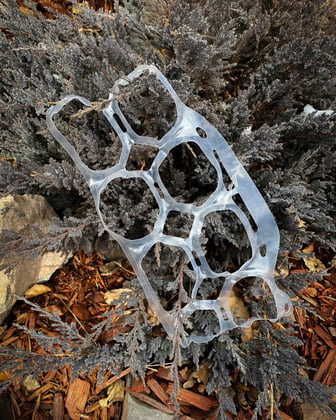
Text and photos by Rick Spitzer
The wildlife around us encounter many hazards. Most are environmental. Some of the hazards involve things we, as responsible citizens, have little control over because they are part of the infrastructure around us controlled by various organizations, companies, and governments.
Examples are power lines without bird guards, that electrocute birds, particularly raptors. Birds are also injured by flying into the lines. Tall buildings injure and kill migrating birds that hit the buildings or fly into reflective glass. Birds have also been killed when they flew into pit toilet and building ventilation pipes. Oil spills kill birds by removing the protective oils in their feathers or actually damaging the feathers and make them useless.
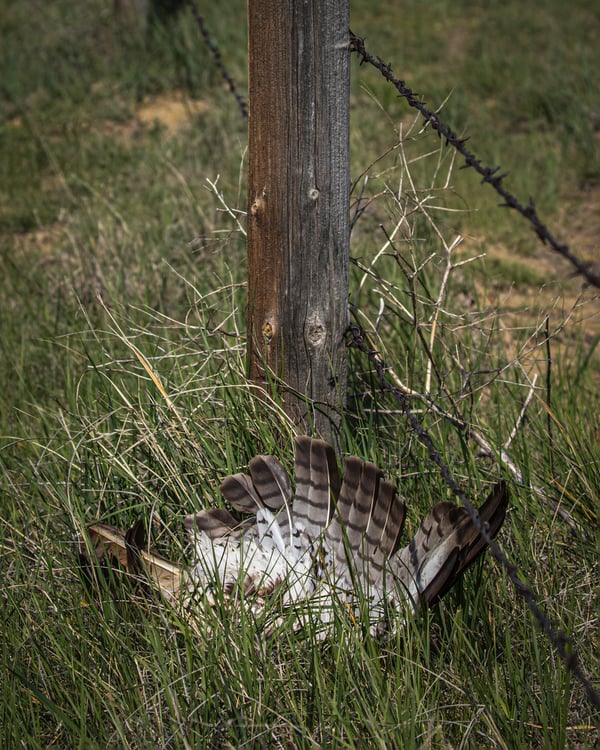
A hawk flying over the prairies collided with a power line above or a wire on the fence and was killed.
We can advocate for wildlife in these situations by contacting the companies and organizations involved. Examples in our area could be when the county or town governments are revising land use regulations. Ensure your voice is heard and protect wildlife interests during public comment periods. In addition, all of us can do things in our own lives to protect and save wildlife from hazards.
What can be done about birds flying into the reflective glass in your house? Decals placed on windows make the window visible to birds. There are also window decals that have a special coating that reflect ultraviolet sunlight. That light is invisible to humans, but birds see it as a brilliant glow on the window. Directions in the packaging will provide ideas to create the best protection.
Around your house there may be items that can trap animals and prevent them from escaping. A container of water like a five-gallon bucket may attract small animals and birds. They fall in and have no way to get out. Swimming pools, small pools, and even wading pools, can trap animals. A board or stick can provide animals with an escape ramp for getting out. If you provide a bird bath in your garden it should be no more than 1/2 to 1 inch at the edges, with a maximum depth of 2 inches deep in the middle. Put buckets and containers inside when not in use or turn them upside down.
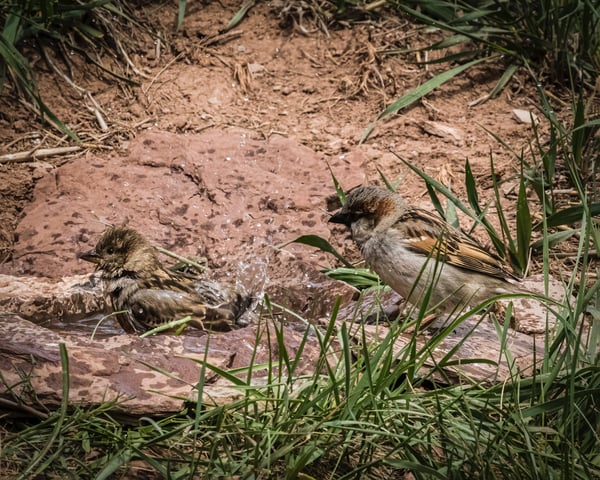
Birdbaths provide water that birds need for survival and provides the water birds use to clean their feathers. Birdbaths should not be deeper than an inch or two.
Many homes have wells for the basement windows. They can trap animals, and many are deep enough that animals cannot fly or jump out. They are usually metal so climbing out is impossible. Prevent critters from getting trapped by covering the openings. If the cover has holes or slots, they should be small enough to prevent an animal from going through them. Again, a board or stick may give a trapped animal a way out.
Dryer vent pipes that vent the drier’s hot air can be particularly attractive to small mammals like chipmunks or small birds. Put a screen or vented cap over the opening. Do not cover or close off the vent pipes or chimney pipes that vent a gas drier’s combustion gases. Vertical, uncapped pipes for fences, or gates can also trap birds and other animals. Put a cap on them.
Other traps for animals are things that entangle them and prohibit normal movement. Tangled animals may not be able to escape from predators or to get the nutrients needed for survival. The plastic that holds pop cans and bottles can entangle birds and other animals. When I was a park ranger in Rocky Mountain National Park, I got a call about a mallard duck caught up in plastic. The birds head was through one opening and a foot was through another opening. That drake’s motion was limited enough that I was able to capture the bird with a net on a long pole. I cut off the plastic and the bird waddled off. After a number of steps, the bird stopped and turn back toward me as if to say thank you. Many animals would not be so lucky. Cutting up all the holes in these plastic holders and disposing of them properly can prevent this problem.
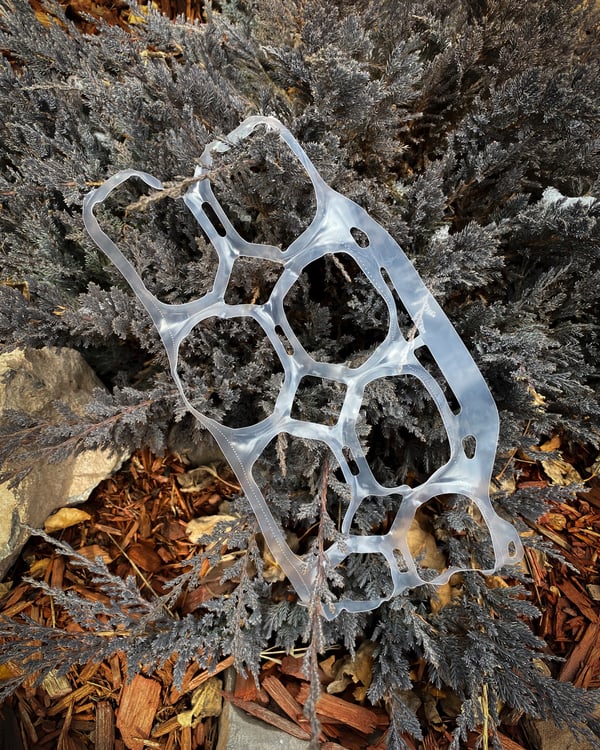
This pop can plastic pack ring can entangle many animals. Cut up the holes and dispose of them properly.
Anglers should never leave fishing line on river and lake banks. Animals can easily get entangled and it often gets worse for them as they struggle. Take the line home or put it in collection boxes or trash cans that keep animals out.
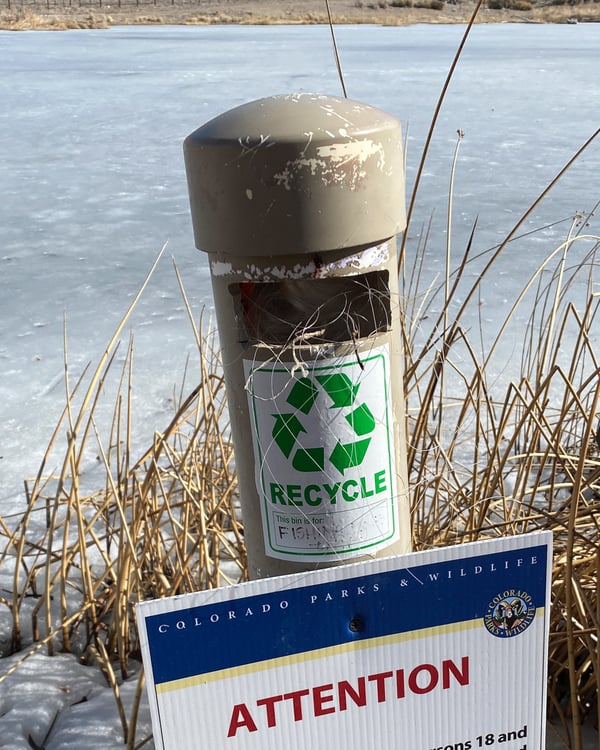
Many areas with a lot of fisherman have disposal pipes for fishing line. This helps keep the line from being litter on the banks of streams and lakes that can entangle animals.
Many people put wire fencing around their lots and gardens. Elk, deer, and other ungulates can suffer a slow, painful death when their legs, horns, or antlers get tangled in fences. The CPW lists the following as issues. Fences that are too high to jump or too low to crawl under. Legs and antlers are easily entangled by fencing that has loose wires and mesh netting. Also, wires spaced too closely together and barbed wire are a problem. Fencing that fleeing animals and birds cannot see can be lethal. Many local governments have enacted fencing ordinances and require permits in order to put up fences. What kinds of fence cause problems for wildlife? The Colorado Parks and Wildlife (CPW) has fencing suggestions to protect wildlife. (https://cpw.state.co.us/Documents/LandWater/PrivateLandPrograms/FencingWithWildlifeInMind.pdf)
.jpeg?width=600&name=Pronghorn020%20(1).jpeg)
Pronghorn often crawl under fences. This Pronghorn got its horns tangled in the lower wires of the fence. The barbs exacerbated the problem. Many ranchers now use non-barbed wire on the lower strand. (The pronghorn did break loose after a 15 minute struggle.)

Mesh fences like this are very dangerous for large animals. If they jump the fence and a hind leg goes through the mesh, the chances for escape are near zero.
We often have problems with unwanted rodents that get into our houses. It is not a good idea to use poisonous baits sold in pellet form, tray form, or in putty formulations outside your house. Rodenticides are often anticoagulants. These compounds cause internal hemorrhaging and will kill a mouse in a few days which is inhumane. You may end up killing many rodents other than mice and you may also kill pets that might get into the baits or eat the mouse that ingested the poison. Choose humane alternatives like repellants to discourage unwanted rodents.
Feeding your pets outside and leaving leftover food in the bowl can attract an incredible variety of wildlife. In addition, wildlife managers encourage you to not feed wildlife such as ducks, geese, gulls, raccoons, deer, squirrels or coyotes around your house or other areas. One way you can help reduce wildlife conflicts with people is by not feeding wildlife, especially near human populations and in parks.
Wildlife managers are often asked to assist with wildlife damage problems related to animals that have been accidentally or intentionally fed by people. Feeding wildlife can lead to a number of serious problems.
• Human food is not healthy for wild animals, and they usually do not need food from humans to survive. Wild animals have specialized diets, and they can become malnourished or die if fed the wrong foods. Also, animals cannot distinguish food from wrappers or foil and can get sick eating these items.
• Feeding leads to public health concerns. Too many animals in one place increases the chance of disease transmission to people and among other wildlife.
• Animals accustomed to people often lose their fear of people and can become aggressive. Those that become too aggressive may have to be destroyed to protect people and property.
• Birds gathering near or on airports can become victims of bird-aircraft collisions, potentially causing flight delays, damage to aircraft, and loss of human life.
• Animals fed along roads tend to stay near roads, increasing the chance of vehicle-animal accidents.
• Large concentrations of ducks and geese can pollute nearby waterways, backyards and athletic fields. Some waterfowl species drop up to a pound of feces every day!
Pesticides and herbicides may impact wildlife indirectly when a part of the habitat or food supply is modified. The term wildlife, as used here, also includes insects, spiders, mammals, birds, fish, amphibians, reptiles, and plants. For instance, herbicides may reduce food, cover, and nesting sites needed by insect, bird, and mammal populations. Insecticides may diminish insect populations fed on by bird or fish species.
Insect pollinators may be reduced by pesticides, thereby affecting plant pollination. When bees ingest nonlethal levels of neuro-active insecticides, their circadian rhythms are disrupted, which means that they lose all sense of time and place. That can cause stress and lower hive survival rates. Spot treating weeds or eliminating pesticide use can help pollinators survive
Pesticides may impact animals by direct or indirect application. Pesticides may drift and when it gets into water the runoff carries it into local water bodies and groundwater. Some animals could be sprayed directly, or they may consume plants or prey that have been exposed to pesticides. Birds exposed to certain pesticides can lose their singing ability and that makes it difficult to attract mates and reproduce. Some deformations have been found in wildlife after exposure to hormone-mimicking pesticides.
For some, ice melt is an absolute necessity during the winter months. Ice-free sidewalks and driveways keep us safe, but what about pets and wildlife? Not all types are safe for use around pets and wildlife. Some are quite toxic when ingested, and may cause irritation to paws, skin, or mucous membranes. Songbirds attracted to salt along roadways are particularly sensitive to road salt. Salt that can enter surface waters will increase chloride concentrations. Chloride is toxic to many species of aquatic wildlife including fish, amphibians, and invertebrates.
Life is a continual struggle for wildlife. These hazards did not exist until people moved into an area with wildlife. Our actions can help to keep them healthier and safer.
The Eagle County Community Wildlife Roundtable is a collaborative partnership with the White River National Forest, Colorado Parks and Wildlife, Bureau of Land Management, local government entities, community members, and citizen scientists. The purpose of the Eagle County Community Wildlife Roundtable is to gather a group of diverse stakeholders in the valley to understand and address issues facing wildlife populations. Together we will identify a shared vision and realistic actions that the community can rally around to support wildlife. We want to leverage diverse values, creativity, and resources to move toward positive action.

Rick Spitzer is the author of the article and official photographer for Eagle County Community Wildlife Roundtable.


Read this article in Spanish here.
What a spectacular area we live in. Recreational opportunities...


*Text and Photos by Rick SpitzerFor many years deer, elk, and bighorn sheep have moved every winter...